Ah…..yoga. What images does it conjure up in your mind? Dark rooms and nature music? Yoga pants that are never worn while actually doing yoga? Hippies and soccer moms chanting together in Sanskrit? Whatever you think it is, we’re here to tell you that what comes to your mind first is probably not the case.
In fact, you could really benefit from taking up yoga.
Believe it or not, yoga is not the same as the photos of spandex-clad women posing on the top of mountains flooding your instagram feed. In fact, one thing beginners may be surprised to learn is that yoga poses (also known as asanas) are only a piece of yoga practice.

- What is Yoga?
- The Eight Limbs of Yoga
- Getting Started with Gear
- The Many Styles of Yoga
- Basic Poses and Sequences You Can Try Today
- Deeper Learning
- Home vs. Studio Practice
- Your First Yoga Class
- Preventing Injuries
- Putting it all Together
**Affiliate disclaimer** Some of the links below are affiliate links, meaning we will get paid a small percent if you decide to purchase through one of them.

Yoga is a 5000 year old philosophy on life from India about harmonizing the body, breathe, and mind to become a more “whole” person. In approximately 400 AD/CE, a dude named Patanjali pulled together the 196 statements that serve as a philosophical guide to the practice of yoga. These statements are outlined in the book “Yoga Sutra” – which is pretty much the “classic” yoga book every serious yogi/yogini (or beginner yogi/yogini) should get around to reading at one point or another.
Fun fact – male practitioners of yoga are called “yogis” while female practitioners of yoga are called “yoginis”. For some reason though, everyone seems to call a practitioner of yoga a yogi…
A guy named Edwin Bryant summarized Patanjali’s description of yoga as “Yoga essentially consists of meditative practices culminating in attaining a state of consciousness free from all modes of active or discursive thought, and of eventually attaining a state where consciousness is unaware of any object external to itself, that is, is only aware of its own nature as consciousness unmixed with any other object.” Yes, that sounds like some new agey shit, but bear with us here – it’s not that crazy.
There are a lot of common misconceptions about yoga. Let’s address these now:
Yoga is not:
- only for the flexible (surprise! those who are currently inflexible may see even better results)
- elegant stretching
- a religion
- a competition to get the most number of likes on social media
Yoga does not:
- stop once you’re off the mat
- require expensive cute outfits
- accept shortcuts
Yoga is:
- a state of mind
- a practice, and just like anything else requires practice to improve
- a way to understand your self
- for everyone
Basically, you don’t have to have gymnast flexibility or a fancy outfit to discover the benefits of yoga. You just need to put aside time to practice and clear your mind of all of the day’s bullshit.
Oh, and by the way, there are many benefits to yoga. These are just some we found from the American Osteopathic Association (osteopathic docs are just like MDs, except they place more emphasis on the musculoskeletal system and how it affects our health) and a roundup of scholarly articles from sonima. The practice of yoga:
- improves cognitive function
- controls diabetes
- helps with stress and anxiety, and depression
- lowers risk of cancer
- promotes a longer lifespan
- reduces symptoms of PMS
- increases flexibility
- helps with chronic pain
- lowers blood pressure
- reduced insomnia
- increases muscle strength and tone
- improves respiration, energy and vitality
- helps maintain a balanced metabolism
- improves cardio and circulatory health
- improves athletic performance
- helps protect from injury
- helps with stress management
- improves mental clarity
Shooooots. With these kind of benefits, why wouldn’t you practice yoga?
Yoga vs. Stretching
Stretching is the lengthening, flexing, or stretching specific muscles or tendons to improve flexibility and decrease risk of injury.
The physical practice of yoga takes the act of stretching and adds in the elements of breathe, focus, alignment, strength, and balance. It may not even include stretching at all. For example, a strong lunge position such as a warrior pose may not focus on stretching certain muscles, but rather strengthening them.
The Yoga Bitches/Jerks
Warning: If you decide to start practicing yoga seriously, you may come across some “holier-than-thou” type yogis. They can vary in appearance from the lululemon clad bitches who judge you as soon as you walk in the studio to the substance/sugar/meat free individuals who have a “I’m morally and spiritually superior than you” type air to them. Ignore these people. You do you. This is not about them. Get to class, get on your mat, and get on with your practice. In that way, you’re already better than them in some aspects of yoga.

The same Pantajali dude we just referenced also developed what are called “the eight limbs of yoga”. These are eight principles (or “limbs) that guide yoga practice. They traditionally refer to Ashtanga yoga – a type of yoga we’ll discuss in the next section – but can be applied to pretty much any style of yoga practice.
- 1. Yama
- The ethical and moral standards and teachings of yoga. Mainly:
- Don’t be violent
- Be truthful
- Don’t steal
- Maintain self-control
- Don’t be a jealous bitch
- The ethical and moral standards and teachings of yoga. Mainly:
- 2. Niyama
- Develop the self-discipline to create good spiritual and personal habits and build grit. Niyama focuses on:
- Inner and outer cleanliness
- Being content with what we have
- Disciplined energy use
- Self-examination
- Contemplation of god/one being/self
- Develop the self-discipline to create good spiritual and personal habits and build grit. Niyama focuses on:
- 3. Asana
- Your body is a temple. Take care of it by practicing asanas (a.k.a postures a.k.a poses)
- 4. Pranayama
- The breath links the body, mind, and soul together. We can practice breathing during yoga practice or on it’s own.
- 5. Pratyahara (withdrawal of senses)
- The conscious detachment from our senses to look inward at ourselves from an outside perspective
- 6. Dharana (concentration)
- Controlling the crazy thoughts that go in and out of our mind
- 7. Dhyana (meditation)
- Uninterrupted focus and concentration
- 8. Samadhi (absorption)
- Enlightenment/ecstasy/pure nothingness
In the eight limbs of yoga, samadhi can be thought of as the ultimate “goal” of yoga. It can be elusive. The idea of confining the mind or fixing it in a well-defined space can sound strange to the beginner, but is something that you may find yourself seeking as you practice more. And with practice, it may become more plausible and attainable.

You may notice that yoga clothing is body hugging. This is not meant as a way to show off hot yoga bods, but is rather a purely functional (okay…and sometimes stylish) choice. Just like how cyclists’ outfits are tight to reduce wind drag, yoga clothes stick to the body so they don’t ride up or fall down when in different poses. As you could imagine, going in to downward dog and having your shirt go over your head is distracting.
Here is the minimum of what you’ll need to get started:
- tight-ish fitting leggings, capris, shorts or other stretchy leg wear
- tight-ish fitting shirt that won’t fall down if bending over
- some space to stretch out
Once you decide to commit to yoga, you may choose to pick up:
- A mat
- yoga props
- yoga block
- yoga strap
- Other yoga specific accessories like yoga socks for extra grippy-ness
- More yoga specific wear (we like athleta, prana, patagonia, gaiam, and lole)
How to Pick Your Mat
A mat is a personal choice. Which one you choose depends on what you like. Mats vary depending on:
- Grippy-ness level
- While most mats are grippy, some are super-duper grippy – which is great if you’re a super duper sweater
- Thickness
- Mats vary from very thin to super thick. Thin mats help you feel more connected to the ground, while thick mats offer more cushion but sometimes less stability for super advanced moves.
- Environmental friendliness
- Cheaply manufactured mats may contain phthalates (i.e. plasticizers) while more expensive mats are made from renewable resources such as rubber. Manufacturers may also differ on views of labor laws, environmental impact, etc.
- Size (width, length)
- The standard size mat is 68 inches (172.7 cm) long
- If you’re tall, you may want to consider a longer mat
- Durability/Quality
- With yoga mats, you generally get what you pay for
- Material (natural rubber vs. synthetic)
- Design (color, print, etc.)
Another big question is, should you buy an expensive mat?
Like my pop-pop always said –
“if it goes between you and the ground, don’t skimp out on it” 
He meant it to not cheap out on purchasing a bed, tires, or shoes. But perhaps a yoga mat may fit in that description, too.
If you think yoga sounds like something you can get into, we say go for the good stuff. After all, it’s pretty much the only piece of gear you really need. Plus, they feel super nice. If you haven’t felt one, get yourself over to an REI or other outdoors retailer to cop a feel for yourself.
Yoga mats also have a “break-in” period where they’re not quite yet their ideal grippy-ness. A mat can be broken in simply by using it a bunch, while others recommend doing a little spa exfoliation of your mat by rubbing it with a salt and water mixture.
Props
Certain props can help you move forward in your yoga practice. The most common ones you’ll see are yoga straps and blocks.
Yoga blocks can help you out when you just don’t have the flexibility or alignment you need to complete a pose, need a bit of extra stability, or can use some extra support. Blocks make poses more attainable and comfortable while you’re working towards getting the whole way there. Even for advanced practitioners, yoga blocks can help deepen stretches and ensure proper alignment.
They come in different materials with the two most common being cork and foam (although you may see an occasional wood one). Materials vary mostly in their durability, weight, and softness.
Foam blocks are the least expensive and most cushy, but are not as durable. Cork blocks aren’t as soft and are heavier, but are more durable and look kinda neat (at least to us). Wood blocks are hard and can be slippery. We would recommend a foam block or two to start off with.
Yoga straps also help you by providing additional support, alignment, and reach where you need it. Can’t quite touch your toes? Place a yoga strap around them to gently move into the pose without straining yourself or throwing off alignment. Awesome!
You may also encounter yoga bolsters or supports, which support your body and help you into a more relaxing position – which is great for restorative yoga.

There are many different styles of yoga.
Let’s cover the ones that you’re most likely to come across as a beginner.
Ashtanga
Combining breathe with a series of postures, ashtanga yoga helps to purify the body and improve circulation, flexibility, mental clarity, and strength. It primarily focuses on the eight limbs of yoga we mentioned above.
Ashtanga is a good choice if you get bored with slower workouts or are a more athletic beginner. As an FYI, power yoga and vinyasa yoga are derived from this style of practice.
Bikram
A standardized set of 26 poses practiced in a 104 degree room for 90 minutes. The element of heat adds an additional challenge for beginners. If you plan on attending a Bikram yoga class, be sure to hydrate properly before class, as you will sweat….a lot.
Hatha
Hatha is a gentle flowing series of postures combined with breathe, meditation, and kundalani to help the practitioner achieve self-realization. Its ease of learning and gentle poses make it a great style for beginners to start off with.
Hot
Hot yoga is similar to Bikram – but only in the way that it is practiced in a heated room. Hot yoga is more free-form and can include postures outside of the 26 included in Bikram. So…its like other types of yoga, but hot. Hence…”hot yoga”.
Kundalini
The “yoga of awareness”, kundalani focuses on awakening the spirit and energy within via postures, meditation, breathing exercises, and mantras.
Restorative
Restorative yoga restores the body and mind through slowly moving through relaxing poses and being still for long periods of time. You’ll find restorative yoga uses a lot of props to really help your body and mind relax. Restorative yoga is great if you’re burnt out or find your mind isn’t firing on all cylinders.
Vinyasa
Vinyasa yoga is a more physical type of ashtanga yoga. In a vinyasa yoga class, you’ll find yourself moving through sun salutations and other sequences while coordinating the breathe between poses. Power yoga is similar to vinyasa, but may include more challenging poses and less rest between poses.
Other types of yoga include anusara, forrest, integral, iyengar, jivamukti, and yin.
This list may be overwhelming to a beginner which is why we recommend not to worry too much about style when you’re first starting out. Feel free to experiment with all types.
However, if you do want to stick to a particular style as a beginner we recommend hatha for its easy, gentle movements.

Once again, we’re going to take a step back to the 8 limbs of yoga. If you may recall, one of the eight limbs is “asanas”, or postures/poses. A posture is a fancy way of saying the place and way in which one sits.
You’ll find that the Sanskrit name of most poses end is “asana”. For example, warrior pose’s Sanskrit name is “virabhadrasana” while locust pose is “salabhasana”. This means should you want to memorize the traditional names of poses, you at least have three syllables already done. Look at you….so pro already!
Below are some poses you can try right now. They’re all great for beginners.
Simply hold each pose for 20-60 seconds depending on your comfort in the pose. For example, if a pose is particularly difficult for you, 20 seconds may be all you need. If you can already do the pose, holding it for longer (30 seconds up to a couple of minutes) can help improve your flexibility and strength.
Be sure to concentrate on your breathe while you move through each pose.
Easy Pose (a.k.a Sukhasana)
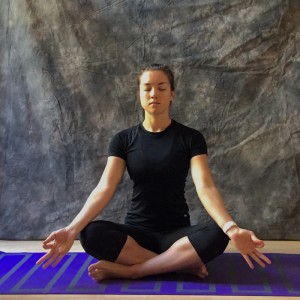
Downward Facing Dog (a.k.a Adho Mukha Svanasana)
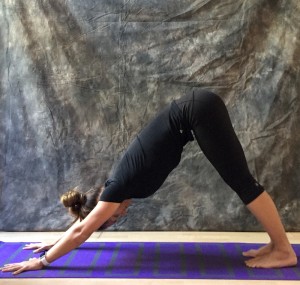
Extended Triangle Pose (a.k.a Utthita Trikonasana)
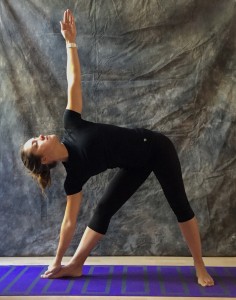
Extended Side Angle Pose (a.k.a Utthita Parsvakonasana)
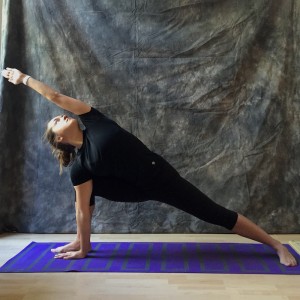
Staff Pose (a.k.a Dandasana)
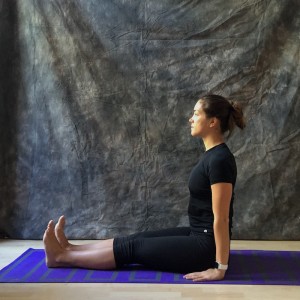
Seated Forward Bed (a.k.a Paschimottanasana)

Bound Angle Pose (a.k.a Baddha Konasana)
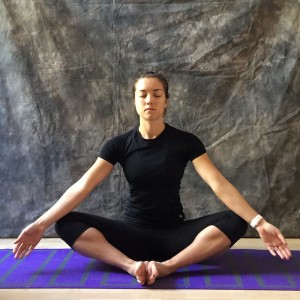
Wide Angle Pose (a.k.a Upavistha Konasana)
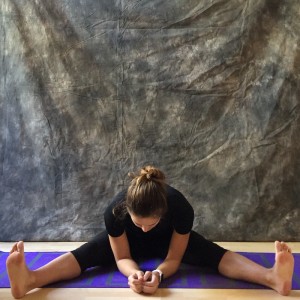
Boat Pose (a.k.a Navasana)
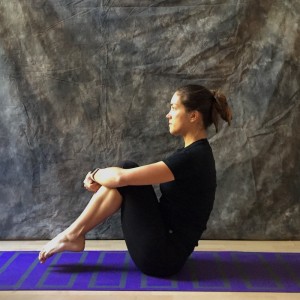
Locust Pose (a.k.a Salabhasana)
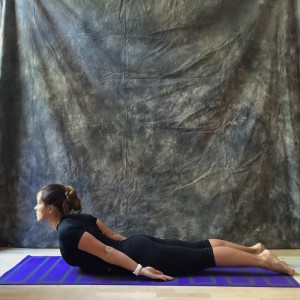
Supported Bridge Pose (a.k.a Setu Bandha Sarvangasana)
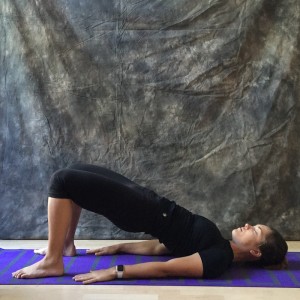
Legs Up the Wall Pose (a.k.a Viparita Karani)
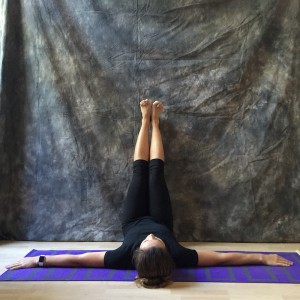
Savasana (a.k.a Corpse Pose)
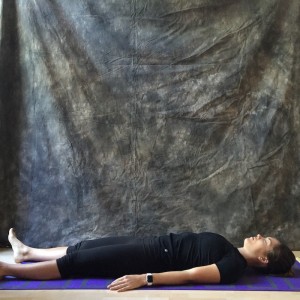
Sequencing
When we move from pose to pose, we are doing what is called “sequencing”. If you’ve ever taken a class or done a video, you’ve already gone through sequences of moves. We’ll start with two sequences to get you going:
- Sun Salutation (a.k.a Surya Namaskar)
- Performing a sun salutation (or a bunch of sun salutations) is a great way to wake up and greet the sun/day. Sun salutations use many of your body’s muscles, so it will get your blood flowing in the morning. Unlike many other types of exercise, sun salutations are simple enough to do in your bedroom right after waking up or even in your kitchen while you wait for your coffee to brew.
- Warrior sequence
- If you’re looking for a physically demanding workout that will get the legs burning, try out this short sequence of warrior poses.

We scoured the yoga forums, countless websites, and message boards. These books were the books that came as most recommended to beginners. Yoga Sutra is the “classic” yoga book that every yogi/yogini looking to evolve their practice should read. Light on Yoga and Yoga: The Spirit and Practice of Moving into Stillness also came highly recommended. For those more interested in how the body uses muscles, joints, ligaments, and other aspects while practicing yoga, be sure to check out the yoga anatomy book.
These books came as the most recommended for beginners looking to understand what the practice of yoga is all about.

The argument of which is better, home practice or studio practice is a long-waging war within yoga circles. Those on the “studio” side tout that there is nothing better than learning yoga directly from a teacher, while those on the “home” side believe that if costs and commutes to a studio are reasons why someone decides not to pick up yoga, then home practice is a completely viable alternative for them and should be encouraged.
Below, we’ll cover the pros and cons of practicing yoga at home versus practicing yoga at a studio:
Home Practice
Pros:
Home practice is best if:
- If you have no studio within driving distance
- You cannot afford or don’t want to pay the $10-30 a drop-in class cost typically costs (monthly passes frequently offered by studios can drop the cost per class down significantly, but you must use them to get their full benefit)
- You want to be able to change teachers fast. If you’re learning from a video and don’t like it, you can just turn it off and find another one that you do like.
- You want to be able to practice at your own pace and on your own schedule
- You prefer to practice alone and don’t like other people joining you in your workout
Cons:
Home practice may not be best for you if:
- You are a true beginner and don’t know where to get started
- You need others to motivate you
- You’re injury prone (a teacher will know the best way to handle injuries and modify poses for you to do so)
- You compare yourself to others too harshly
- There is not enough space in your house for you to lay out a mat & stretch out
Studio Practice
Pros:
Studio Practice is best if:
- You want to learn the proper ways to do poses
- You want someone to fix your mistakes as you learn
- You need personalized instruction for specific conditions like injuries or pregnancy
- You prefer a more structured environment and routine
- You enjoy the available camaraderie of a group class
- You are easily distracted at home by chores, kids, pets, etc.
Cons:
Studio practice may not be best for you if:
- You’re on a tight budget
- You’re on a tight schedule
- You prefer the privacy of your own home
- You want to learn poses not offered in classes
- You want to go through poses at your own pace
Where you decide to practice is a personal choice. However, we would recommend to beginners that they take a few classes at a studio to get the gist of things before moving to practicing at home. But if you’d like to get started at home instead, here are a few places where you can find videos and resources for beginners.
- Yoga with Adrienne
- YogaYak
- Do Yoga With Me
- Esther Ekhart
- Videos from your good ol’fashioned local library
Other Learning Resources

Before we can talk about your first yoga class, we have to point out that your experience will be different if you decide to take a class at your local studio or at your gym. There are a few differences you should be aware of:
Studio: experience built around yoga, multiple different classes/styles, pay per class/monthly/yearly, soothing environment, more experienced teachers, you can probably find one within a stone’s throw of your house
Gym: experience built around working out, one or two different classes/styles, typically included in a gym membership cost, perhaps not a soothing environment, teachers typically newer, let you get your cardio and yoga in at the same time
Your First Class
For your first class there are really only a few things you need to know
- Wear yoga appropriate clothes (things that won’t fall over your head or get in the way)
- There should be mats and props there for you to borrow
- You may want to refrain from eating right beforehand until you know how your stomach reacts to the workout
- If you would like, let the instructor know that you’re a beginner and/or if you have any conditions that need special treatment
The “Flow” of a Class
This is just an example. Please note that not every class will follow the same sequences of events and/or poses.
- The class will typically begin with a simple breathing exercise or meditation to get your mind relaxed and ready for class
- There will then be a “warm-up” type period where you may do some stretches to get your body ready for sun salutations
- Do some sun salutations (or other sequences)
- Move into yoga poses
- standing poses
- arm balances
- inversions (these are usually in advanced classes only. If they do these in the class you’re attending, it’s totally appropriate to just hang out in a comfy pose)
- upper body poses
- backbends
- twists
- forwards bends
- etc.
- Relax as you come into savasana – or corpse pose for a few minutes to relax after a well-done class
Frequency of Practice
How often should you practice? That’s up to you. You can practice yoga every day if you want to – as evidenced by the popular instagram hashtag of #yogaeverydamnday

While it’s gentler than other exercises, yoga still poses a risk of injury – especially when it is not practiced correctly. Some of the more common injuries include those of the wrist, back, and knees. Let’s briefly discuss some key takeaways to avoid injury while practicing yoga.
Rule #1: Always Warm-Up Before Attempting Challenging Poses
Protecting Your Wrists
- Practice core strength (seriously, it helps put less pressure on your wrists)
- Try yoga wrist pads/sliders (like these)
- Plant your palm first, then splay out your fingers, try just balancing on your fingers, or try balancing with your hands in fists instead (keep trying until you find a position that works for you)
- Shift weight away from your wrists by bending your knees or switching to your forearms
- Soft yoga mats can cause the heel of you hand to drop and put extra stress on your wrist, so counter-intuitively, try a harder surface
- Try “lifting your energy” back up towards your shoulder instead of down into your wrists
- If it feels unnatural, don’t push it
Protecting Your Back
- In twist poses, don’t twist too far beyond your comfort zone or to the point where breathing becomes uncomfortable
- Maintain a slight bend in the knees when bending over such as in forward folds and downward dog
- Instead of “rolling up”, do more of a “hinge up” by coming up to a neutral spine parallel to the ground and hinge up like you can see here
- If it feels unnatural, don’t push it
Protecting Your Knees
- The knee bone is connected to the …. hip bone…and the knee bone is connected to the…foot bone. So to help out your knees, warm up that butt of yours and splay out those toes
- If you’re plagued with knee problems, avoid cross-legged sitting and lotus pose (that one where your legs look like pretzels….yeah….best avoided when your knees hurt)
- Don’t ever let the kneecap move past/go over the foot
- Don’t lock the knee and just hang out…this can result in hyperextension and hyperextension = bad
- Use a bolster between the upper and lower legs when appropriate
- If it feels unnatural, don’t push it
When in doubt, listen to your body and don’t push it
Yoga with Existing Injuries
Since we don’t know what your specific injury is over the interwebz, our only advice to you can be to go to a class and let your teacher know, or head to a doctor or other healthcare provider for some qualified medical advice.

Yoga is a great way to relax, breathe, clear your mind, and challenge your body.
Just remember that yoga is a practice. It takes practice to improve and perfect poses. It can take just as much time to quiet your mind for more than a few seconds and just sit still.
Regardless, we sincerely hope that you pick up yoga as an activity you enjoy. It has so many benefits that we think you may be crazy to not.
If you enjoyed this piece, be sure to subscribe to our newsletter. You’ll receive awesome and actionable pieces of advice, tips, hints, and tricks to make beginning yoga something you will enjoy and look forward to #everydamnday.
Disclaimer: The information presented herein is offered only as-is for informational and educational purposes and is not a substitute for the professional judgment of a medical professional.Use your own discretion when performing any postures. Work at your own level and explore your own limits. The reader and viewer of the information presented by this site assumes all risks when using the information provided herein. This site’s operators, authors, owners, and affiliates disclaim any and all liability from the information provided herein. Any medical, financial, legal, health, psychological or other information provided on this site is not intended as a replacement for professional consultations with qualified practitioners.



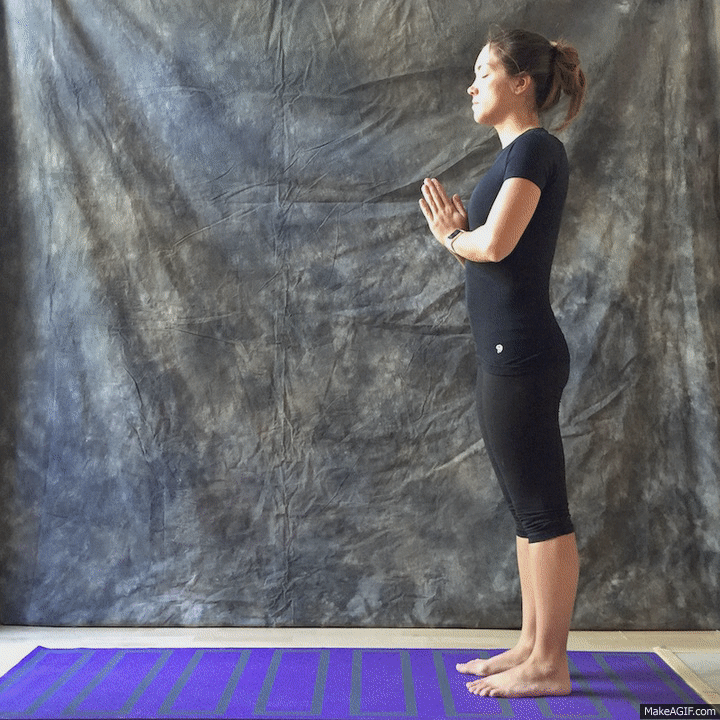
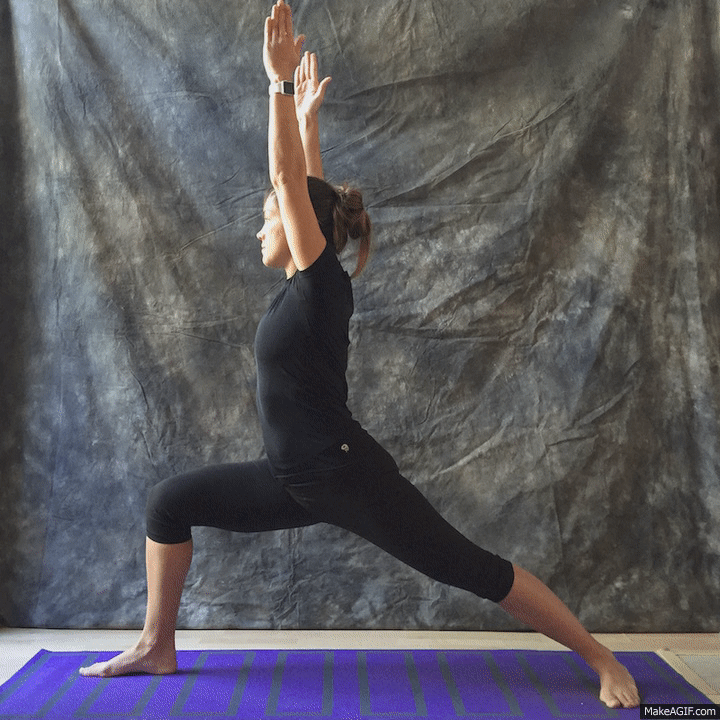

[…] Here are some of the more common words you may overhear when getting in to yoga. This list could have been more extensive by covering the various types of yoga as well as the eight limbs of yoga, but you’re unlikely to come across them in a beginner environment. If you want to know more about them though, just check out our ultimate beginners guide to yoga. […]